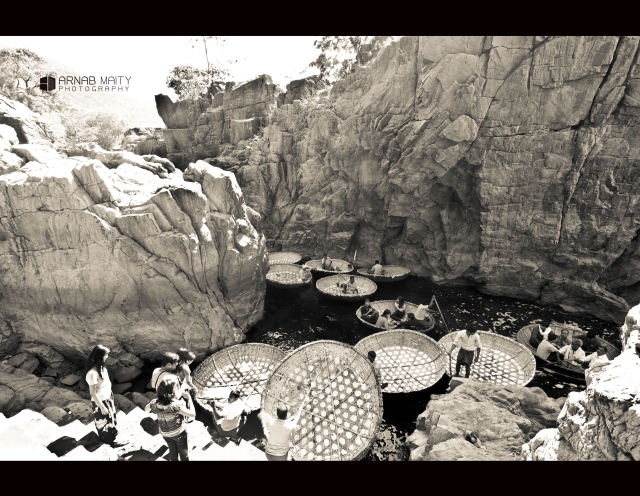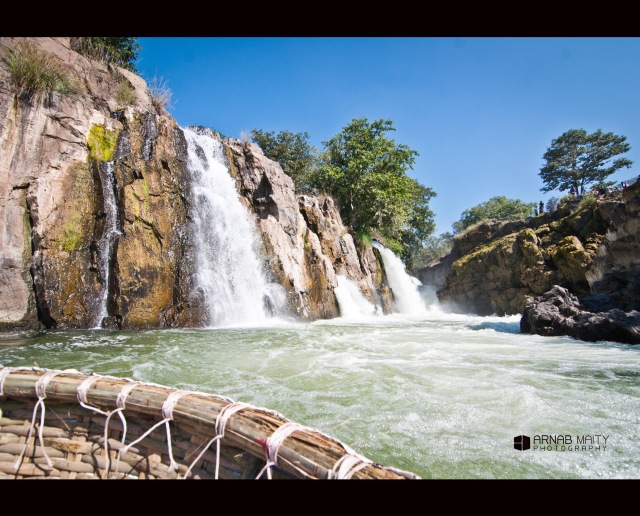The curves, neatly rock-fenced; the green mulberry trees aligned along the trails, veering away into the dense vegetation; the gradual decent into a valley through a sun-dappled thoroughfare; a huge saucer shaped black umbrella exposing only a pair of tanned legs, trudging to a nearby hamlet of concrete block houses. This is Hogenakkal, at the borderland between two of India’s southernmost states, Tamil Nadu and Karnataka, in conflict over the waters of Kaveri since decades.
As my motorcycle screeches dustily to a halt at the parking area, an ensemble of local touts, fixated at offering a boat ride, swarms me. The boat isn’t the traditional one, but like a round saucer shaped basket, made of bamboo frames, plastic and buffalo hides. They look very similar to the coracles, popular in Wales and other parts of England,though entirely different in the make. In the next few hours, I find them at all corners, sometimes lying idle on the river bank, hung from a tall tree branch or ornamenting the back of a boatman, carrying it with ease and shouting out my ignorance at christening them as umbrellas in the first look.
Being a weekend, the place was lively with tourists. In the demarcated bathing area, ladies in their colorful saris and bangles, pushed and shoved each other to get drenched in the soothing Kaveri waters, known to have medicinal properties. Hogenakkal, has been a popular riverine spa since a long time and local tourists throng the place all year long, to catch a glimpse of the gorging Kaveri blowing smoke up, as she dances down into the granites and carbonatites. “A bath in her waters, washes your sins and offers you a natural massage” chuckled Saravanan, a resident of Vellore and a regular visitor here. If he came to wash his sins, was difficult to determine, but could be a probable reason, since he went on to get an artificial massage from one of the dozen masseurs armed with a bottle of herbal oil in his disposure. The masseurs along with the boatmen thrive in this riverine economy and so does the ubiquitous fish seller with a deep fry unit and a plate embellished with fresh catch marinated in turmeric paste and salt.
We managed to strike a deal for a three hour-long coracle ride, to explore the other side of the river and the main falls area, which was unreachable on foot. Crossed a small stream, walked a couple of wooden boardwalks and we were on an island with a vantage point, that offered panoramic views of the series of waterfalls, gushing into the narrow gorge and creating a smoky ambience. No marks for guessing how this place got its name; ‘hoge’ means smoke in Kannada and ‘kal’ stands for rocks.

A few steps down on the ghat to the river and I stood still for a few moments, there was a circular form of the floating markets of Thailand in front of me, coracles loading and unloading beverages and confectionaries to feed the thirsty and hungry tourist under a brazing sun. Sitting on the flat-bottomed coracle didn’t look scary to me, but my co passengers let out their skeptical sighs and murmurs, only to bring out the outstretched cry of Muthu, our boatman- “Its safe saaar”. Muthu wasn’t just another rower and I was fascinated by the skills he showed en route. The closer we went to the Tamil Nadu side of the falls, the difficult it was to keep the boat on track but he was manoeuvring it with perfection; rotating the watercraft with his guts out leading to a linear motion with help from the rapids, at times spinning the heads, inducing vertigo.

The cruise through the gorge with granite rocks doing the tall fencing, shifted me to the numerous song sequences of Indian movies, being shot here. They have made this place popular, but it still holds a certain charm and impresses the most scrupulous traveler. The dark complexioned water and the stillness at places, talks about the depth of these channels. ”More than hundred feet, saar”, exclaims Muthu, thereby getting the facts ready for me. After temporarily disembarking the primitive vessel, we hike a short distance to see the main falls, de routing from the concrete bridge and watchtower for an amazing view. The jump from the railings of the bridge, followed by a minute trek on the slippery rocks didn’t look menacing until we encountered a troop of macaques, who were ready to pounce on any attractive object in the hand, in their unique snatch-and-run game. I was left clinging to my camera and eventually called it quits, before the primates got a taste of its plastics.


On our way back to the boarding point, Muthu parked the vessel on a shallow island propped up at the center of the meandering river. A family, who had all the frolic by taking incessant dips on the waist deep water, conquered the place. We stood in knee-deep water at a distance and watched their child-like water splash games. Being in no mood to get wet, we were sure to have missed the pleasure. Back to where we started and the golden hues of the setting sun gave me some snaps to treasure throughout my life. The only thing that I missed on this trip was a ‘high drama’, I thought in an attempt to start my motorcycle at the parking lot. Switched on the ignition, but the vehicle refused to move with ease, it swayed itself on the road, like a drunkard with no defined trajectory. I stopped the ignition and whoa, what do I see? The flat rear tire lying dead on the road, ringing the bell of the onset of a high quality evening drama!



What followed in the next half an hour wasn’t less than a well written movie script, I was swarmed by auto rickshaw drivers, who offered me a to and fro ride to Pennagram (16 km away) for 1000 rupees, to find a puncture repair mechanic. Then came the accommodation agents, who referred to the will of goddess Kaveri to have me stalled here and I should stay in one of their recommended lodges for the night, as per her wish. The adamant that I am, I pushed the heavy machine on the road towards the main square in search of a cycle repair shop at least. Help came from an elderly gentleman, who showed me the way to one. By the time, I dragged the monster to the shop it had been closed for the day. After an uncounted number of requests and pleads, the mechanic, who lived in the same house as the shop, was convinced of my need to go back to Bangalore that night and started working on the fix. The fix took 3 more hours, but it ensured I return safely, in spite of the misaligned wheel-fitting job by him.
I was back again on the curves,this time pitch dark and quiet, with only the headlight showing me the way in the forest. There wasn’t much time left for midnight and Christmas Eve was about to make way for Christmas. My arm was rendered numb by the nippy air, but my mind was frequenting back to half a hundred miles, to the gorges of Hogenakkal, to the roars of Kaveri!
–>
How to Reach:
Car/Bike:
Hogenakkal Falls can be visited as a day trip from Bangalore. There are 3 routes to reach Hogenakkal, the shortest is via Denkanikottai, which is about 130 kms. The roads are decent on this stretch,head towards Anchetty from Denkanikottai and then Hogenakkal. Make sure you take a right turn from the main signal on NH 7 at Hosur, underneath the flyover.
The second route is via Rayakottai, which is about 170 kms.This route has excellent roads with minimum traffic. Take a right diversion from Hosur just after exiting from the Hosur flyover, make sure you see the sign board with Rayakottai written on it.
The third route is via the silky smooth NH 7 till Krishnagiri. Take a right diversion towards Dharmapuri and continue on the Dharmapuri-Hogenakkal road. This is the longest route, being about 190 kms, but you can easily do 3 figures on your odo.
Public Transport :
The nearest airports are at Bangalore and Coimbatore
The nearest railheads are Dharmapuri, Salem and Morappur.
There are frequent private buses from Bangalore or Salem towards Hogenakkal. Get on a bus towards Rayakottai or Pallakodu from Shanthinagar in Bangalore and there are many buses to Hogenakkal from these places.
Where to Stay:
There are limited options to stay at Hogenakkal, TTDC run hotel, looked the best option there. Check out Adhiyaman Palace or Rama Boarding in case you don’t find a place in the TTDC hotel. I would suggest to stay at Dharmapuri instead, which has much better options.
What to Do:
Take a bath at the main bathing area or at the smaller falls after crossing the hanging bridge. Take a coracle ride to see the main falls, the rates may vary,should be around Rs.150 per person for a one-hour ride. Feed yourself with fresh fish fries, unless you are too fussy about hygiene. Get yourself a massage with the herbal oils from the local masseurs.
